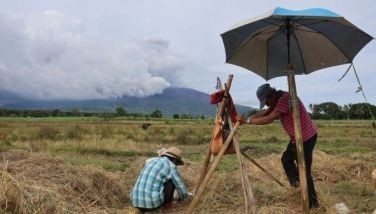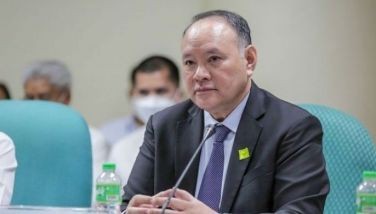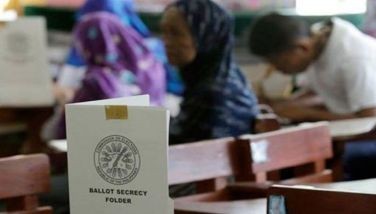GMA, Japan PM inaugurate ‘3-G’ trains
December 10, 2006 | 12:00am
President Arroyo and Japan Prime Minister Shinzo Abe led the inauguration yesterday of the third-generation (3-G) commuter trains of the Light Rail Transit Authority (LRTA) acquired by the Philippines through a soft loan from Tokyo.
The President arrived at the LRTA compound in Pasay City a little past 11 a.m. with the Japanese prime minister on board a black limousine.
The area was secured tightly with several other foreign VIPs, mostly from Japan, gracing the inauguration.
During the ceremony, Mrs. Arroyo and Abe cut the ceremonial ribbon and poured champagne on the front of one of the 3-G trains, after which butterflies were set free from their cages to complete the inauguration.
During the test ride, the President chatted with Abe in one of the 3-G trains. They were with LRTA Administrator Melquiades Robles and other Philippine and Japanese dignitaries, including those from the Japan Bank for International Cooperation (JBIC).
In a statement, the President said her government was "greatly indebted" to the Japanese government for its "substantial contribution" to the rail project.
"Commuters will undoubtedly enjoy not only the reduced travel time, but increased comfort and less pollution as well," she said.
Abe expressed hope the new trains "will provide the Filipino people more convenience in their everyday life by decongesting Metro Manila transport and will contribute to the economic development of the Philippines."
Robles said the procurement of the 3-G trains is part of the scope of the LRT Line 1 Capacity Expansion (CAPEX) Project II (Package A) that is funded by the JBIC.
In line with the President’s goal of decongesting Metro Manila and of providing a seamless and convenient mass transportation within the rail network, Robles said this project was approved to become eligible for financing.
The LRTA said the event showcased the long-standing economic cooperation between Japan and the Philippines.
The P8.893-billion loan from the JBIC is payable in 30 years at one-percent interest, with payments starting only after a 10-year grace period, the LRTA said.
The loan was used to acquire 12 four-car trains, of which 10 have been delivered, repair stations and install air-conditioning units in older Belgian-made coaches.
"The CAPEX is an P8.893 billion-worth loan, funded through the first stage of the Obuchi fund, which has a concessional interest rate of one percent per annum. We are very much thankful to the government of Japan, through the JBIC, for all the help they have given us," he said.
Among those who attended the inauguration were Transportation and Communications Secretary Leandro Mendoza, Land Transportation Franchising and Regulatory Board (LTFRB) chairman Thompson Lantion, and Metro Rail Transit (MRT) general manager Roberto Lastimoso.
Robles noted that the Japanese government has been extending financial support to the LRTA since 1993 for major railway projects, the latest of which is the CAPEX.
The loan assistance is composed of two packages.
Package A, Robles said, consists of the acquisition of the 12 four-car trains and related system and civil works such as major renovations at the EDSA and Doroteo Jose LRT stations, which link the LRT Line 1 system to the Metro Rail Transit (MRT) Line 3 and LRT Line 2 systems, respectively.
This also involves the provision of escalators and elevators and a cross-over bridge at the Doroteo Jose station, improvements in other stations to resolve the perennial queues of passengers at the ticket booths, gates and access ways, and the construction of a modern Operations Control Center (OCC) at the depot area to centralize control of the operations in the Line 1 system.
On the other hand, Package B, which has already been completed, pertains to the installation of air-conditioning units in the old fleet, said Robles.
The CAPEX was undertaken in preparation for the construction of the North and South Line Extensions, he said.
The North Extension project, which is pegged at $120 million, linking LRT Line 1’s Monumento station to MRT’s North EDSA station, will commence in January and will be available to the public by May 2010.
The South Extension project from the Baclaran station to Bacoor, Cavite will start as soon as all the budgetary requirements are in place.
The project was endorsed by the National Economic Development Authority-Investment Coordinating Council (NEDA-ICC) Technical Board to the ICC-Cabinet Committee for approval next week, Robles said.
Robles said the objective of this project is to increase the capacity of LRT Line 1 from 27,000 passengers per hour per direction to 40,000 per hour per direction.
Meanwhile, the Metro Rail Transit Authority (MRTA) is planning to procure 48 cars for $48 million for its expansion project starting next year.
During yesterday’s blessing of the LRTA’s 3-G trains, MRT general manager Roberto Lastimoso said the plan was to acquire 48 second-hand cars and convert these into 12 four-car trains.
A car would cost about $1 million each, including refurbishments, conversion and delivery to the Philippines.
"The immediate plan is the acquisition of more rolling stocks because our system is now bursting to the seams. It is only designed for 350,000 (passengers) maximum capacity (per day). It is now carrying an average of 450,000 (passengers), which is 100,000 more than we can carry (per day)," Lastimoso said.
"So we are buying more vehicles for stock, and because the need is immediate, we have shopped, and looked around in Germany and Austria," he added.
Lastimoso said he has recommended that the MRT will be getting the first set of four-car trains by April or May 2007, but this would depend on how fast it can be approved.
One offer, he said, came from Dusseldorf, Germany while another is from Hanover. One other offer came from Vienna, Austria. — Sandy Araneta, AP
The President arrived at the LRTA compound in Pasay City a little past 11 a.m. with the Japanese prime minister on board a black limousine.
The area was secured tightly with several other foreign VIPs, mostly from Japan, gracing the inauguration.
During the ceremony, Mrs. Arroyo and Abe cut the ceremonial ribbon and poured champagne on the front of one of the 3-G trains, after which butterflies were set free from their cages to complete the inauguration.
During the test ride, the President chatted with Abe in one of the 3-G trains. They were with LRTA Administrator Melquiades Robles and other Philippine and Japanese dignitaries, including those from the Japan Bank for International Cooperation (JBIC).
In a statement, the President said her government was "greatly indebted" to the Japanese government for its "substantial contribution" to the rail project.
"Commuters will undoubtedly enjoy not only the reduced travel time, but increased comfort and less pollution as well," she said.
Abe expressed hope the new trains "will provide the Filipino people more convenience in their everyday life by decongesting Metro Manila transport and will contribute to the economic development of the Philippines."
Robles said the procurement of the 3-G trains is part of the scope of the LRT Line 1 Capacity Expansion (CAPEX) Project II (Package A) that is funded by the JBIC.
In line with the President’s goal of decongesting Metro Manila and of providing a seamless and convenient mass transportation within the rail network, Robles said this project was approved to become eligible for financing.
The LRTA said the event showcased the long-standing economic cooperation between Japan and the Philippines.
The P8.893-billion loan from the JBIC is payable in 30 years at one-percent interest, with payments starting only after a 10-year grace period, the LRTA said.
The loan was used to acquire 12 four-car trains, of which 10 have been delivered, repair stations and install air-conditioning units in older Belgian-made coaches.
"The CAPEX is an P8.893 billion-worth loan, funded through the first stage of the Obuchi fund, which has a concessional interest rate of one percent per annum. We are very much thankful to the government of Japan, through the JBIC, for all the help they have given us," he said.
Among those who attended the inauguration were Transportation and Communications Secretary Leandro Mendoza, Land Transportation Franchising and Regulatory Board (LTFRB) chairman Thompson Lantion, and Metro Rail Transit (MRT) general manager Roberto Lastimoso.
Robles noted that the Japanese government has been extending financial support to the LRTA since 1993 for major railway projects, the latest of which is the CAPEX.
The loan assistance is composed of two packages.
Package A, Robles said, consists of the acquisition of the 12 four-car trains and related system and civil works such as major renovations at the EDSA and Doroteo Jose LRT stations, which link the LRT Line 1 system to the Metro Rail Transit (MRT) Line 3 and LRT Line 2 systems, respectively.
This also involves the provision of escalators and elevators and a cross-over bridge at the Doroteo Jose station, improvements in other stations to resolve the perennial queues of passengers at the ticket booths, gates and access ways, and the construction of a modern Operations Control Center (OCC) at the depot area to centralize control of the operations in the Line 1 system.
On the other hand, Package B, which has already been completed, pertains to the installation of air-conditioning units in the old fleet, said Robles.
The CAPEX was undertaken in preparation for the construction of the North and South Line Extensions, he said.
The North Extension project, which is pegged at $120 million, linking LRT Line 1’s Monumento station to MRT’s North EDSA station, will commence in January and will be available to the public by May 2010.
The South Extension project from the Baclaran station to Bacoor, Cavite will start as soon as all the budgetary requirements are in place.
The project was endorsed by the National Economic Development Authority-Investment Coordinating Council (NEDA-ICC) Technical Board to the ICC-Cabinet Committee for approval next week, Robles said.
Robles said the objective of this project is to increase the capacity of LRT Line 1 from 27,000 passengers per hour per direction to 40,000 per hour per direction.
During yesterday’s blessing of the LRTA’s 3-G trains, MRT general manager Roberto Lastimoso said the plan was to acquire 48 second-hand cars and convert these into 12 four-car trains.
A car would cost about $1 million each, including refurbishments, conversion and delivery to the Philippines.
"The immediate plan is the acquisition of more rolling stocks because our system is now bursting to the seams. It is only designed for 350,000 (passengers) maximum capacity (per day). It is now carrying an average of 450,000 (passengers), which is 100,000 more than we can carry (per day)," Lastimoso said.
"So we are buying more vehicles for stock, and because the need is immediate, we have shopped, and looked around in Germany and Austria," he added.
Lastimoso said he has recommended that the MRT will be getting the first set of four-car trains by April or May 2007, but this would depend on how fast it can be approved.
One offer, he said, came from Dusseldorf, Germany while another is from Hanover. One other offer came from Vienna, Austria. — Sandy Araneta, AP
BrandSpace Articles
<
>
- Latest
- Trending
Trending
Latest
Trending
Latest
Recommended































